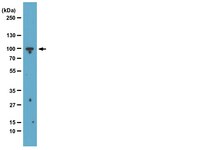The Scaffold attachment factor b1 (Safb1) regulates myogenic differentiation by facilitating the transition of myogenic gene chromatin from a repressed to an activated state.
Hernández-Hernández, JM; Mallappa, C; Nasipak, BT; Oesterreich, S; Imbalzano, AN
Nucleic acids research
41
5704-16
2013
요약 표시
The regulation of skeletal muscle gene expression during myogenesis is mediated by lineage-specific transcription factors in combination with numerous cofactors, many of which modify chromatin structure. However, the involvement of scaffolding proteins that organize chromatin and chromatin-associated regulatory proteins has not extensively been explored in myogenic differentiation. Here, we report that Scaffold attachment factor b1 (Safb1), primarily associated with transcriptional repression, functions as a positive regulator of myogenic differentiation. Knockdown of Safb1 inhibited skeletal muscle marker gene expression and differentiation in cultured C2C12 myoblasts. In contrast, over-expression resulted in the premature expression of critical muscle structural proteins and formation of enlarged thickened myotubes. Safb1 co-immunoprecipitated with MyoD and was co-localized on myogenic promoters. Upon Safb1 knockdown, the repressive H3K27me3 histone mark and binding of the Polycomb histone methyltransferase Ezh2 persisted at differentiation-dependent gene promoters. In contrast, the appearance of histone marks and regulators associated with myogenic gene activation, such as myogenin and the SWI/SNF chromatin remodelling enzyme ATPase, Brg1, was blocked. These results indicate that the scaffold protein Safb1 contributes to the activation of skeletal muscle gene expression during myogenic differentiation by facilitating the transition of promoter sequences from a repressive chromatin structure to one that is transcriptionally permissive. | 23609547
 |
Coordinated regulation of transcriptional repression by the RBP2 H3K4 demethylase and Polycomb-Repressive Complex 2.
Pasini, Diego, et al.
Genes Dev., 22: 1345-55 (2008)
2008
요약 표시
Polycomb group (PcG) proteins regulate important cellular processes such as embryogenesis, cell proliferation, and stem cell self-renewal through the transcriptional repression of genes determining cell fate decisions. The Polycomb-Repressive Complex 2 (PRC2) is highly conserved during evolution, and its intrinsic histone H3 Lys 27 (K27) trimethylation (me3) activity is essential for PcG-mediated transcriptional repression. Here, we show a functional interplay between the PRC2 complex and the H3K4me3 demethylase Rbp2 (Jarid1a) in mouse embryonic stem (ES) cells. By genome-wide location analysis we found that Rbp2 is associated with a large number of PcG target genes in mouse ES cells. We show that the PRC2 complex recruits Rbp2 to its target genes, and that this interaction is required for PRC2-mediated repressive activity during ES cell differentiation. Taken together, these results demonstrate an elegant mechanism for repression of developmental genes by the coordinated regulation of epigenetic marks involved in repression and activation of transcription. | 18483221
 |
The polycomb group protein Suz12 is required for embryonic stem cell differentiation.
Pasini, Diego, et al.
Mol. Cell. Biol., 27: 3769-79 (2007)
2007
요약 표시
Polycomb group (PcG) proteins form multiprotein complexes, called Polycomb repressive complexes (PRCs). PRC2 contains the PcG proteins EZH2, SUZ12, and EED and represses transcription through methylation of lysine (K) 27 of histone H3 (H3). Suz12 is essential for PRC2 activity and its inactivation results in early lethality of mouse embryos. Here, we demonstrate that Suz12(-/-) mouse embryonic stem (ES) cells can be established and expanded in tissue culture. The Suz12(-/-) ES cells are characterized by global loss of H3K27 trimethylation (H3K27me3) and higher expression levels of differentiation-specific genes. Moreover, Suz12(-/-) ES cells are impaired in proper differentiation, resulting in a lack of repression of ES cell markers as well as activation of differentiation-specific genes. Finally, we demonstrate that the PcGs are actively recruited to several genes during ES cell differentiation, which despite an increase in H3K27me3 levels is not always sufficient to prevent transcriptional activation. In summary, we demonstrate that Suz12 is required for the establishment of specific expression programs required for ES cell differentiation. Furthermore, we provide evidence that PcGs have different mechanisms to regulate transcription during cellular differentiation. | 17339329
 |
Genome-wide mapping of Polycomb target genes unravels their roles in cell fate transitions.
Bracken, Adrian P, et al.
Genes Dev., 20: 1123-36 (2006)
2006
요약 표시
The Polycomb group (PcG) proteins form chromatin-modifying complexes that are essential for embryonic development and stem cell renewal and are commonly deregulated in cancer. Here, we identify their target genes using genome-wide location analysis in human embryonic fibroblasts. We find that Polycomb-Repressive Complex 1 (PRC1), PRC2, and tri-methylated histone H3K27 co-occupy >1000 silenced genes with a strong functional bias for embryonic development and cell fate decisions. We functionally identify 40 genes derepressed in human embryonic fibroblasts depleted of the PRC2 components (EZH2, EED, SUZ12) and the PRC1 component, BMI-1. Interestingly, several markers of osteogenesis, adipogenesis, and chrondrogenesis are among these genes, consistent with the mesenchymal origin of fibroblasts. Using a neuronal model of differentiation, we delineate two different mechanisms for regulating PcG target genes. For genes activated during differentiation, PcGs are displaced. However, for genes repressed during differentiation, we paradoxically find that they are already bound by the PcGs in nondifferentiated cells despite being actively transcribed. Our results are consistent with the hypothesis that PcGs are part of a preprogrammed memory system established during embryogenesis marking certain key genes for repressive signals during subsequent developmental and differentiation processes. | 16618801
 |











